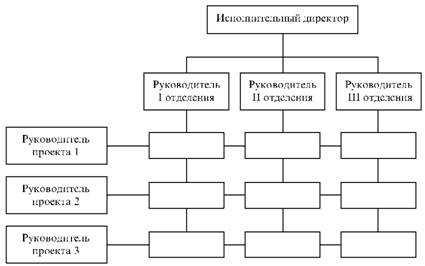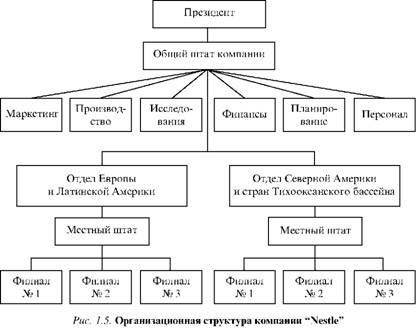home
 Management Management
 International Management - Rodchenko VV International Management - Rodchenko VV
|
International Management - Rodchenko VV
1.4. The organizational structure of corporations and companies in the international practice
The management structure reflects the shape, ie. e. the structure, management of the subject device, the method of its internal organization, communication elements of the subject among themselves (order, subordination of the individual elements of the administrative apparatus), allowing to carry out the necessary control functions. Management structure provides stability, the stability control system, so that it retains its properties when the external or internal conditions. The structure of the enterprise management reflects objectively folding management relations in the framework of the production system. Control systems have a hierarchical structure with the distribution of the vertical functions, responsibilities, rights and responsibilities.
The organizational structure of the enterprise - is the organic unity of the organizational management structure and the structure of production; It is this unity is unthinkable. The structure of any company reflects the ordered arrangement of its elements and form of their relationship. The organizational structure is needed to manage different areas of activity of the enterprise and analysis of the advantages and disadvantages of different approaches to building management system allows you to make the right choice in favor of a particular organizational structure, taking into account market conditions and business strategy. Depending on the two major types of business enterprise conditions (stable and changing) may be effective in the traditional market or institutional structure.
Traditional linear structure divided into functional and mixed. Market structures arise with the development of market relations while increasing instability in the functioning conditions of firms, companies, industries, and their quest to adapt to new conditions.
View the organizational structure depends on a number of factors. For example, the large role played by company size and business size. It happens that in large organizations activity is mainly concentrated in one or more areas. Some organizations working directly on the needs of the general population, some, on the contrary, is concerned mainly with other large companies, some operating in geographically limited areas, while others - in almost all countries of the world. The organizational structure should be possible to meet the goals and objectives of business. The best structure allows the organization to more effectively interact with the environment, to achieve its goals with the greatest efficiency. In addition, the structure of the organization is to ensure the implementation of its strategy.
Since over time the strategy change, it is not excluded and the corresponding changes in organizational structures.
To determine the quality of any type of organizational structures are the most important characteristics of the following:
• systems approach;
• optimal combination of centralized management and local self-government;
• clear definition of roles, responsibilities and rights of each of the components of the structure;
• maximum reduction of travel time information from senior management to the direct executors;
• creation of a rapid response mechanism to changes in the organization of production and demand for manufactured products;
• the authority to address issues in each case that unit, which has a maximum of information on the subject;
• widespread use of collective forms of management of the organization;
• adaptation of individual units control unit to the whole system and the whole system to the external environment.
All variety of modern organizational structures of companies can be reduced to various modifications of linear, functional and mixed.
Simple organizational structure is characterized by small firms engaged in small business. Such an organization can work effectively until it reaches a certain critical size beyond which control the efficiency decreases significantly. This critical size depends mainly on the nature of the business. For example, a broker may conduct business with significant turnover, while another business with the same turnover require changes in organizational structure.
The functional structure is based on the solution of functional tasks, such as manufacturing, finance and accounting, marketing, and personnel. This type of structure has proven effective in multinational companies. Initially, functional structure was characterized by small companies with a small list of products. Now and multinational companies use separation of its activities in the functional areas of management. Like any other, the functional structure has its advantages and disadvantages. It allows you to monitor the activities at higher levels, giving a clear definition of roles and tasks, but does not fit with broad diversification. An example of the functional structure can serve as the organizational structure of the airline BLB (Fig. 1.1). The disadvantages of this structure are minimized by improving the coordination of the functional departments, as well as the creation of sub-market-oriented.

The main characteristic of the divisional structure organization is the division into parts (unit), which can be formed based on types of products or services, geographic area or on certain consumer orientation (Fig. 1.2).

Divisional structure arises on the basis of functionality, but it solves the problem of the diversification of production. In the framework of each department can concentrate on the challenges and opportunities of a particular business environment. When constructing di vizionalnoy structure raises the question of the division of administrative structure of objects to be produced on the basis of principle. If the company can not decide whether to put the basis for a grocery or regional basis, the mixed type of organizational structure may occur.
The advantage of a divisional structure is the ability to track the activities of each business unit as a separate direction. However, it also has disadvantages, since the monitoring process becomes much more complicated.
The structure of the holding company. The holding company, in fact, is an investment. It may consist of joint-stock companies of different activities, for which the corporate center provides granular control, even though, as part of the parent company, each company operates independently and can even save your own name. An example of a holding company structure is shown below (Fig. 1.3).

The advantage of the holding company can be considered the fact that it provides considerable freedom of action and independence of its structural components. Companies that make up the holding, work and develop their potential more effectively if they have greater independence, particularly in a rapidly changing environment. Subdivisions - affiliated companies may be fully or partially owned by the parent company. They also benefit due to the membership of the group. This structure of the negative side is the increased risk of strategic inconsistency and duplication of the structural units.
The matrix structure is a combination of different types of organizational structures (Fig. 1.4). Usually it takes the form of product and regional or functional and divi-zionalnoy structures working together.
Purely functional and divisional structures can not be used as the basis for building a management structure is several factors. For example, if a company is expanding its activities to multi-national level and developing new production lines, for the coordination of the development of production and distribution on a global scale it may require subdivision built by product basis.

Fig. 1.4. General view of the matrix structure
The matrix structure is typical not only for large, complex organizations; it is also used in small organizations, especially in companies that provide professional services.
The advantages of this structure are the high quality of decision-making in the event of conflicts of interest between departments, replacing bureaucracy direct contacts, increase motivation for activities, training managers by involving them in decision-making on many issues. Disadvantages are manifested in the increase in the adoption of decisions, confusion and blurring of tasks and responsibilities, a high level of conflict and ambiguity in selecting priorities.
The matrix organization is typically created for large-scale and complex challenges for the integration of the various activities in the company by means of an increasing number of communication channels and decision-making centers. An important part of the matrix structure is the use of various types of semi-autonomous groups or collectives. An example of such an organization can serve as a firm 1VM.
Intermediate structures and structural variations. In practice, very few organizations have a clean structure type of the above. The organizational structure of the company should be possible to meet the internal and external factors, so there is a whole range of administrative structures between pure structural types. Organizational structures vary from time to time to comply with the new or changed environmental circumstances of the environment. For example, a company can go from functional to divisional structure through a series of small structural changes.
Network and virtual organization relates to new types of organizational structures. The rapid development of information and computer technologies, lower prices for telecommunications equipment and increasing their efficiency has led to the possibility of their use by small and medium-sized companies that serve to improve the management process. Progress Informatics destroyed closure of inefficient institutions and made those who used traditional bureaucratic structures. Information and computer revolution and the associated changes in the external environment have led to the emergence of new types of successful companies in this environment, which include edho-ocratic, multidimensional and market-oriented.
For edhokraticheskoy organization structure is characterized by a concentric shape, which is a point of reference. This structure is best suited to the advisory novovvedencheskoy, computer, electronic, research and development and design areas.
On the basis of the matrix model, you can build a multi-dimensional organization, adding a third dimension. Then, in the organizational structure included such important variables as the territory of the market and the consumer. The basis of the multidimensional organization is an autonomous working group, whose members relationships with management and other departments do not differ from the relations with foreign customers. An example of a multi-dimensional organization can be experimental "Volvo" team of the company.
Organization, market-oriented, is flexible, adaptive and innovative. It amplifies the grouping of works on the markets, greater effort is made to adapt the product to the consumer, the product can change frequently, accelerated the flow of information. Thus, the structure of the company is becoming increasingly networked character.
Virtual structure is an existing computer networks the relationship between individual people who can do the job alone, however, remain bound to each other and the main corporate resources (database, expert advice), with colleagues, suppliers and customers through a telecommunications and computer infrastructure.
The basic form of the organizational structure in a multinational company is the main link of the organizational structure "at home" with a foreign branch, which is controlled by means of direct contact with the general manager of the department executive director of the parent company. Here are the forms of the structures of multinational companies: branch, subsidiary, branch abroad, multinational company.
For example, "Nestle" company, which was founded in Switzerland, felt the need to enter the international market, internationalized their activities through the establishment of overseas offices around the world. The organizational structure of the company (Fig. 1.5) is based on the geographical principle, which involves the local managers responsible for business management, while the main guide holds in its hands the planning and control. All geographical regions, including the base (Swiss) market, equal rights in the organizational

plane. This arrangement is effective for "Nestle" and other companies with similar product lines and markets end-users.


Comments
Commenting, keep in mind that the content and the tone of your messages can hurt the feelings of real people, show respect and tolerance to his interlocutors, even if you do not share their opinion, your behavior in terms of freedom of speech and anonymity offered by the Internet, is changing not only virtual, but real world. All comments are hidden from the index, spam control.